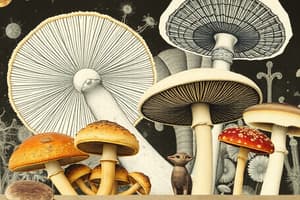Podcast
Questions and Answers
What is mycology?
What is mycology?
Study of fungi (yeasts and molds)
Eukaryotic organisms are distinguished by which of the following?
Eukaryotic organisms are distinguished by which of the following?
- Rigid cell wall composed of chitin and glucan
- Cell membrane that contains ergosterol
- Both A and B (correct)
- None of the above
Fungi are considered as either:
Fungi are considered as either:
- Saprobes
- Symbionts
- Commensals
- All of the above (correct)
How are fungi classified taxonomically?
How are fungi classified taxonomically?
What are yeasts?
What are yeasts?
What describes molds?
What describes molds?
When growing on solid surfaces, molds produce what type of hyphae?
When growing on solid surfaces, molds produce what type of hyphae?
Many fungi of medical importance are dimorphic.
Many fungi of medical importance are dimorphic.
How do most fungi perform respiration?
How do most fungi perform respiration?
Fungi are ______ compared to most bacteria.
Fungi are ______ compared to most bacteria.
Fungi reproduce by the formation of what?
Fungi reproduce by the formation of what?
The form of fungus producing sexual spores is the ______ and the form producing asexual spores is the _____
The form of fungus producing sexual spores is the ______ and the form producing asexual spores is the _____
The anamorphic (asexual) state is isolated from what?
The anamorphic (asexual) state is isolated from what?
Asexual spores consist of which types?
Asexual spores consist of which types?
What are conidia?
What are conidia?
What are sporangiospores?
What are sporangiospores?
What are superficial mycoses?
What are superficial mycoses?
What do cutaneous mycoses affect?
What do cutaneous mycoses affect?
What are subcutaneous mycoses?
What are subcutaneous mycoses?
What are endemic mycoses?
What are endemic mycoses?
What are opportunistic mycoses?
What are opportunistic mycoses?
All primary systemic fungal pathogens are agents of respiratory infections.
All primary systemic fungal pathogens are agents of respiratory infections.
What are the phases of fungal disease?
What are the phases of fungal disease?
Flashcards are hidden until you start studying
Study Notes
Mycology Overview
- Mycology is the study of fungi, which includes yeasts and molds.
Eukaryotic Characteristics
- Fungi are eukaryotic organisms with a rigid cell wall made of chitin and glucan.
- The cell membrane contains ergosterol, unlike bacteria that contain cholesterol.
Types of Fungi Based on Habitat
- Saprobes: feed on dead or decaying matter.
- Symbionts: live in mutual benefit relationships.
- Commensals: one organism benefits while the other is unaffected.
- Parasites: exploit hosts for benefit, potentially harming them (pathogens).
Taxonomic Classification
- Fungi are classified based on morphology and mode of spore production.
Yeast Characteristics
- Yeasts are unicellular, reproduce asexually through budding or fission.
- Daughter cells may elongate into pseudohyphae, and colonies appear round and mucoid on agar.
Mold Characteristics
- Molds are multicellular with hyphae that elongate apically.
- Hyphae can form mycelium and colonies that are described as filamentous or hairy.
Molds on Culture Media
- When growing on agar, molds produce vegetative hyphae and aerial hyphae.
Dimorphic Fungi
- Many medically significant fungi exist in both yeast and mold forms.
Fungal Respiration
- Most fungi practice aerobic respiration; some can also perform fermentation or are anaerobic.
Growth Rate
- Fungi grow more slowly than most bacteria.
Fungal Reproduction
- Fungi reproduce via spores, which can be sexual or asexual.
Fungal Morphological Forms
- Teleomorph refers to the sexual spore-producing form, while anamorph refers to the asexual spore-producing form.
Clinical Specimen Isolation
- Asexual states (anamorphic) of fungi are isolated from clinical specimens.
Types of Asexual Spores
- Asexual spores include sporangiospores (contained in a sporangium) and conidia (naked, produced on special structures).
Superficial Mycoses
- Affect the outer skin and hair, with non-destructive cosmetic implications.
Cutaneous Mycoses
- Involve the keratinized layers of skin, hair, and nails, may elicit host immune responses, leading to symptoms like itching or scaling.
Subcutaneous Mycoses
- Impact deeper skin layers, cornea, muscle, and connective tissue, often introduced through trauma, can cause abscesses and nonhealing ulcers.
Endemic Mycoses
- Caused by dimorphic pathogens, true pathogens that primarily affect healthy individuals.
- Notable examples: Histoplasma capsulatum, Blastomyces dermatitidis, Coccidioides spp., Paracoccidioides brasiliensis.
- Exhibit thermal dimorphism—yeast form at 37°C and mold form at 25°C.
Opportunistic Mycoses
- Typically human commensals or environmental fungi with limited virulence, causing infections primarily in immunocompromised individuals.
- Major causative agents include Candida spp., Cryptococcus neoformans, Aspergillus spp., and Pneumocystis jirovecii.
Primary Pathogens and Respiratory Infections
- All systemic fungal pathogens are agents of respiratory infections.
Fungal Disease Phases
- Saprobic phase: characterized by filamentous septate hyphae in soil producing airborne infectious cells.
- Parasitic phase: able to grow at 37°C and reproduce, typically within a host.
Studying That Suits You
Use AI to generate personalized quizzes and flashcards to suit your learning preferences.




